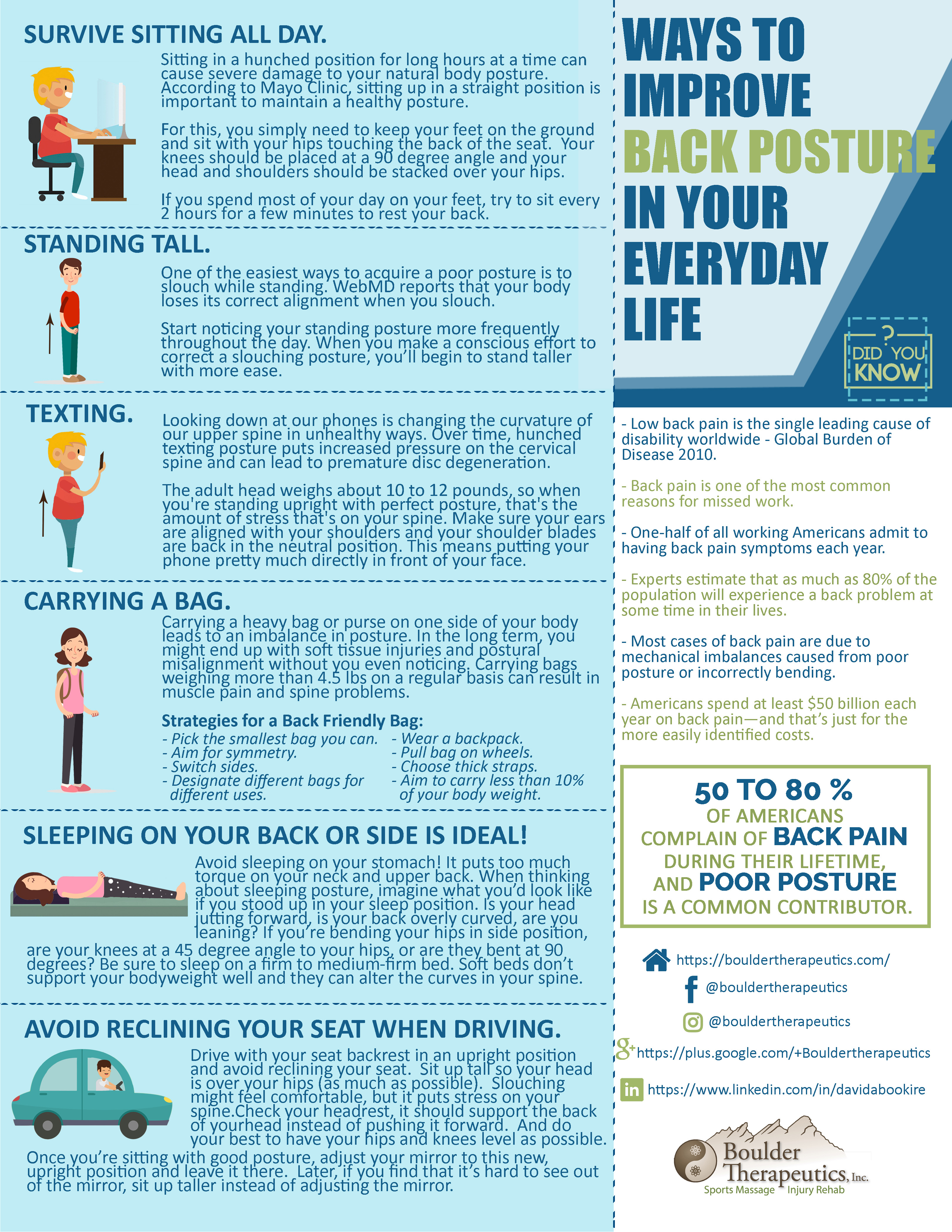 Improve your posture
Improve your posture
As kids, our parents used to point out our poor posture. They would remind us of ways to improve posture, much to our dismay and embarrassment. We know that constant reminders of proper posture can get annoying, but we can never overstate how important it is to find good alignment.
Even if you didn’t listen to your parents back in the day and are experiencing back or neck discomfort, it may not be too late to unwind your patterns and to fix your body position. In this post, you will learn:
- What it means to have good posture.
- The benefits of good alignment.
- Why you have bad body mechanics.
- The best ways to improve posture.
What is good posture and why do we need it?
Posture defines our body’s position and alignment as we stand, sit, or lie down. Gravity pulls down on our bones, joints, ligaments, and muscles, especially as we become more active.
To prevent putting our bodies under so much stress, good posture corrects the alignment of our structure. This allows for proper distribution of the force of gravity through our body. We become more efficient and move with less effort. Muscle groups such as hamstrings and the large back muscles play a significant role in good posture. If these postural muscles function properly, they help prevent gravitational forces from putting a strain on our bodies. They also help maintain balance as we move.
Below are the benefits of having good body mechanics:
- eliminates muscle fatigue
- minimizes the possibility of injuries on our ligaments
- prevents back and muscular pain
- aids in easier and deeper breathing
- improves circulation and digestion
Good posture also improves our confidence. A social psychologist Amy Cuddy explains in a TED talk that having a good alignment impacts the way others see you. Someone who stands up straight looking authoritative and confident is much more appealing than someone who slouches a lot. Not only will the first make you look taller, it will also make you exude a younger aura while slouching makes you look anti-social or unhappy.
The following can cause poor posture:
- lack of body awareness
- constant stress of life
- obesity
- pregnancy
- possess weak or abnormally tight postural muscles
- wearing improper shoes (like high-heels)
- working under poor conditions
- moving, sitting or standing improperly
Poor posture is often treatable, and it starts with awareness and education. Also, you can improve your lifestyle choices such as losing weight, wearing proper shoes, etc. For this post, however, we will teach you simple ways to improve posture so you can correct your alignment over time!
The best ways to improve posture
For those having problems with their posture, here’s an infographic that shares with you the different ways on how to improve your alignment at work, home, and everywhere in between. Please feel free to click here for a printable version to keep as a reminder.
1. Protect your body at work
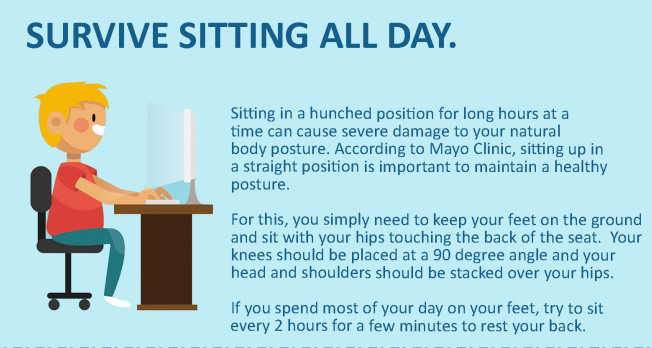
Sitting in a hunched position for long hours at a time can alter posture. If your job involves long hours of sitting, then your muscles and joints can get stiff, weak or imbalanced, causing you to have back pain from your poor posture.
For this, you need to keep your feet on the ground and sit with your hips touching the back of the seat. You should place your knees at a 90-degree angle and stack your head and shoulders over your hips. It also helps to invest in an adequate back support which helps achieve good posture by filling in the gap between your lower back and the seat, supporting the natural inward curve of the lower back. To see actual photos of proper seated posture, click here.
If a back support is not available, you can opt to adjust your workstation and the height of your chair so you can sit up closer to what you are doing. Keep your shoulders relaxed by resting your elbows and arms on your desk or on your chair, and sit up tall, tightening your abdominals slightly.
If you spend most of your day on your feet, try to sit every 2 hours for a few minutes to rest your back.
For more information, read Seated Posture: Proper Alignment to Avoid Neck and Back Pain
2. Good posture in school
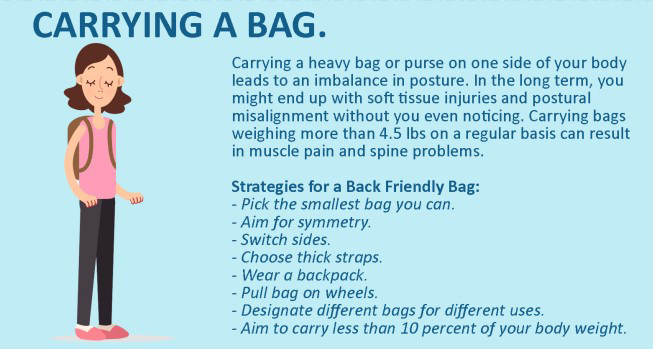
Carrying a heavy bag or purse on one side of your body leads to an imbalance in body position. In the long term, you might end up with soft tissues injuries and postural misalignment without even noticing. Regularly carrying bags weighing over 4.5 lbs can cause muscle pain and spinal problems.
Below are strategies for a back-friendly bag:
- pick the smallest bag you can
- aim for symmetry
- switch sides
- choose thick straps
- wear a backpack
- pull bag on wheels
- designate different bags for different uses
- aim to carry less than 10 percent of your body weight.
“Always ask yourself how to better distribute the load,” says Natalie Lovitz, Clinical Director of Professional Physical Therapy in New York City. “Rearranging the bag by putting heavy items closer to the body and at the bottom of the bag can help.”
3. Good alignment while sleeping
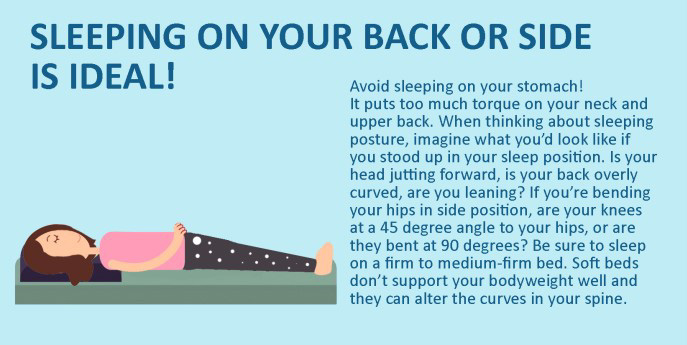
Avoid sleeping on your stomach! It puts too much torque on your neck and upper back. When thinking about sleeping posture, can you imagine how you’d look if you stood up in your sleep position? Is your head jutting forward? Is your back overly curved? Are you leaning? If you’re bending your hips in side position, are your knees at a 45-degree angle to your hips or are they bent at 90 degrees?
Be sure to sleep on a firm to medium-firm bed. Soft beds don’t support your bodyweight well and they can alter the curves in your spine. Remember to always use a pillow to support your head at an elevated position to the rest of your body for proper blood circulation.
Click here for more information about the proper sleeping posture.
4. Body mechanics while using your phone
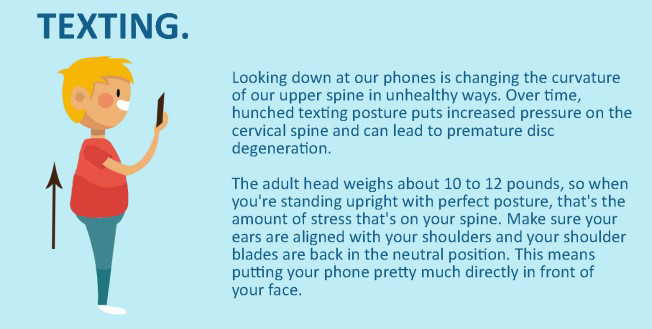
The average smartphone user spends two to four hours a day on their phones or computer. That results in 700 hours a year of looking at phones and computer screens!
Looking down at our phones is changing the curvature of our upper spine in unhealthy ways. Over time, hunched texting posture puts increased pressure on the cervical spine and can lead to premature disc degeneration. It can also cause your lungs to lose 30 percent of their breathing capability.
The adult head weighs about 10 to 12 pounds, so when you’re standing upright with perfect posture, that’s the amount of stress that’s on your spine. Align your ears with your shoulders and your shoulder blades back in their neutral position. This means holding your phone up almost directly in front of your face.
5. How to fix posture while driving
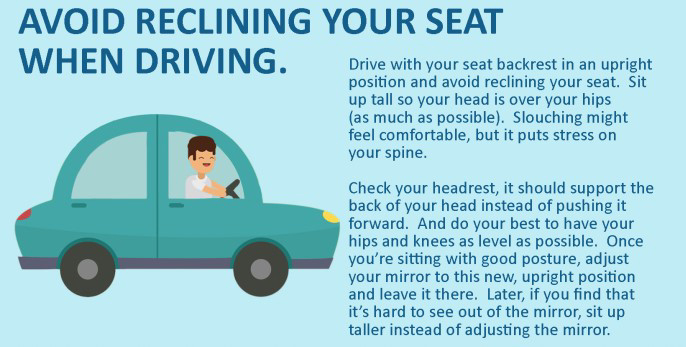
Poor body position while driving can lead to serious back and neck pain.
Maintain proper posture by driving with your seat backrest in an upright position and avoid reclining your seat. Sit up tall so your head is over your hips (as much as possible). Slouching might feel comfortable, but it puts stress on your spine.
Check your headrest, it should support the back of your head instead of pushing it forward. And do your best to have your hips and knees as level as possible. Once you’re sitting with good posture, adjust your mirror to this new, upright position and leave it there. Later, if you find it’s hard to see out of the mirror, sit up taller instead of adjusting the mirror.
Like a lumbar support at work, you can also opt to invest in a support cushion behind your lower back to help maintain proper posture.
6. Best body positions while standing and walking
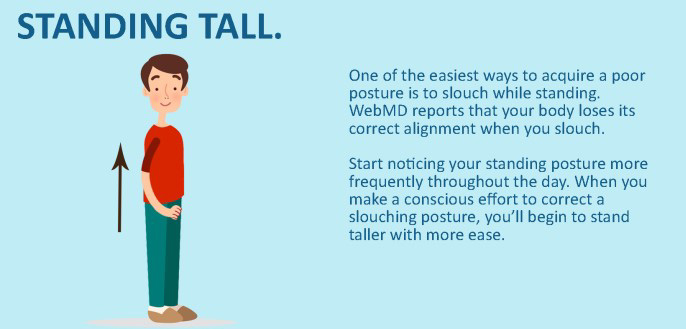
One of the easiest ways to create poor posture is to slouch while standing or sitting. WebMD reports that your body loses its correct alignment when you slouch. Be mindful of your standing posture more frequently throughout the day. When you consciously correct a slouching posture, you’ll stand taller with more ease.
Proper posture while walking is almost the same as with standing. Just remember to not lean forward or lean back as it puts a strain on the back muscles as you walk. Keep your eyes forward and chin up (parallel to the ground). Have your shoulders back and relaxed and slightly tone your stomach to resist slouching or leaning.
These ways to improve your posture should make your life much easier!
Good posture is very important to our overall health and well-being. We believe positive encouragement, awareness and education can help you remember to focus on healthy postural habits. By following the ways to improve posture in this post, you can benefit from better mobility, less physical pain, and have a much more fulfilling life.


